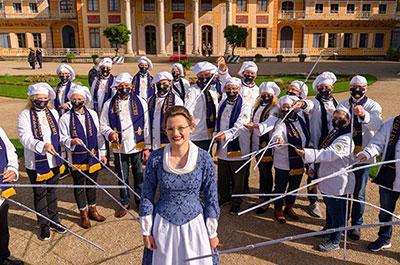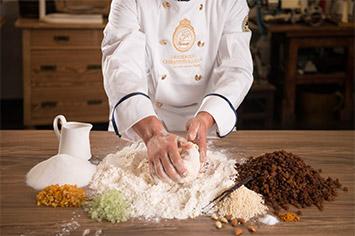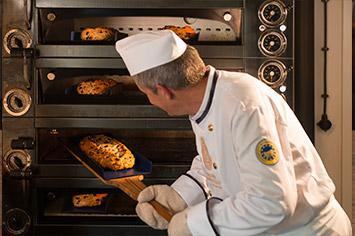
Dresdner Christstollen PGI is a yeast-raised wheaten loaf, speckled with fruits, nuts, and spices.
Traditional bakers and pastry-makers craft their loaves by hand, following recipes that stretch back centuries.
Once baked and buttered, the final product is dusted with a flurry of icing sugar as a sweet and festive final touch.
Origins
The history of Dresdner Christstollen PGI is adorned with as many colourful fancies as facts. Some believe that the product originated from a baking competition held by a German bishop in 1329. Others ascribe the name stollen (meaning ‘tunnel’ in German) to the history of tin and silver mining in the area surrounding Dresden.
What is known for sure, however, is that Dresdner Christstollen PGI has a long association with the yuletide season, stretching back as far as medieval Saxony. The name of Dresden’s famous Christmas market, the Dresdner Striezelmarkt, comes from the word “strüzel” or “stroczel”, referring to the simple yeast pastries from which stollen evolved.

The first recorded mention of “stollen” comes in 1474, when the Advent period was a time of fasting in Catholic Germany. The product appears on a bill at the hospital of St. Bartholomew, where it is referred to as a fasting food made of flour, yeast and water. The austerity of the ingredients was enforced by the Catholic Church who, in 1450, placed a ban on baking with butter during Advent. As a result, bakers could only use oil, which resulted in a dull and flavourless cake.

In response to the situation, Prince Ernst, Elector of Saxony, and his brother Duke Albrecht wrote to Pope Nicholas V, requesting that Saxon bakers be allowed to use butter in their stollen. The pope refused. It would take the passing of forty years and four more popes before Rome relented. In 1490, Pope Innocent VIII issued his “Butterbrief” (i.e. butter missive), a papal decree that excluded Dresden’s stollen bakers from the 1450 butter ban.
From then on, stollen grew in popularity as a festive treat. By 1530, the product appears in records as “Christstollen”, suggesting its deepening connection with the Christmas period. Thirty years later, a tradition emerged among the bakers of Dresden to present Saxony’s rulers with festive stollen every Christmas. On one occasion, eight master bakers and their journeymen paraded a loaf of 18 kilograms through the city before offering it to the palace.
An even larger loaf was commissioned in 1730 by Augustus the Strong, Elector of Saxony, King of Poland, and Grand Duke of Lithuania. The Saxon ruler was hosting the Zeithainer Lustlager military display and required a dessert to impress his 24,000 guests. Roughly one hundred bakers and their journeymen joined forces, mixing 3,600 eggs, 326 churns of milk and 20 hundredweight of flour to create a giant stollen of 1.8 tonnes.

The display of 1730 inspired the subsequent Stollen Festival, held every year in Dresden on the day before the second Sunday of Advent. The festival features a procession of performers and bakers, who carry a giant stollen through the streets of the city. The patron of the festival is the Dresdner Stollenmädchen, a young woman selected for her knowledge of the craft.
The festival is organised by the Stollen Association, comprised of the local bakers and pastry-makers who produce Dresdner Christstollen PGI. The enduring popularity and reputation of their product can be seen in the two million loaves that are sold around the world every year.
In 2010, the European Union recognised the distinctive qualities and heritage of Dresdner Christstollen by certifying the product as a protected geographical indication (PGI).
Production
Dresdner Christstollen PGI is produced in a select number of bakeries and pastry shops, all located within the city of Dresden and twelve surrounding municipalities.

The bakers begin by combining wheat flour, yeast and whole milk into a heavy dough. The dough is brought to life through the addition of sultanas and candied orange or lemon peel, as well as sweet and bitter almonds and a selection of spices. Although bakers draw from a particular set of ingredients and must follow fixed proportions, many add the touches of their own traditional recipes, some of which have been passed down from medieval times.
The dough is left to rest, then shaped by hand. Bakers cut and tear the dough into sections, which they shape and roll it into loaves. A knife is run along the middle of the loaf, which is then put into the oven upon a flat surface. The loaves are never placed in baking tins or moulds, thereby retaining their hand-shaped form. The loaves are first baked at a medium temperature for a short period of time, then for a longer period at a lower temperature.

Once thoroughly baked and suitably browned, the loaves are removed from the oven, before being coated with butter and powdered with icing sugar. When cut, the jewelled crust crumbles to reveal a treasure of dried and candied fruit, which blend with the almonds and spices to create a loaf that is rich in aromas and flavours.
The smells and tastes of the loaf are preserved by immediate packaging. The packaging must display the protected geographical indication logo, as well as the “golden seal” of the Stollen Association, which denotes the assigned approval number of the manufacturer and depicts Augustus the Strong astride his horse, an assurance that the product has been made in accordance with its deep traditions.
More information
Dresdner Stollen PGI – legal specifications
